Top News
February 25, 2015 Ryukyu Shimpo
The Okinawa Development Finance Corporation, on February 25, revealed the result of a survey on labor scarcity and its impact. The companies that answered “already facing scarcity of employees” and “expecting to face scarcity of employees,” accounted for 54.4 percent of respondents. The shortage is felt most in the food and beverage and accommodation industries, with 90.9 percent of companies lacking both full-time employees and casual employees. Among the companies facing labor shortage, the amount that answered “scarcity of employees affects the operation of business,” amounted to 52.3 percent of the whole industry. The figure is expected to reach 92.4 percent soon.
The biggest effect of labor shortage for 60.3 of survey respondents is “extension of work time.” Some of the firms see the effect in a “delay in the opening of new stores or revising of the business plan” due to the worker shortage in the construction industry.
The corporation has expressed concern as the labor shortage makes it difficult to meet demand. The quality of service in the hospitality industry seems to be suffering, and it is concerning that this condition may become drastic during the peak season in summer, which may also negatively influence the image of Okinawa tourism.
The survey was conducted from the end of November 2014 to early February this year, with 323 companies out of 367 contacted companies responding – a response rate of 88 percent. The survey did not include nursing care or child-minders. A summary of the survey is also open to the public on the Finance Corporation’s website.
(English translation by T&CT and Sayaka Sakuma)
Go to Japanese
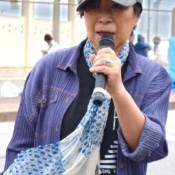
February 27, 2015 Ryukyu Shimpo
On February 26, Kayoko Ikeda, who is a well-known translator of various kinds of texts including German literature, visited Camp Schwab gate in the Henoko district of Nago. Her translation works include Night and Fog, Sophie’s World, and If the World Were a Village of 100 People. Ikeda, who actively speaks out against changes to Japan’s constitutional peace clause, said, “Suppose Japan had 100 people, only one person, Okinawa, bears 70 percent of the heavy burden of the U.S. military.” She added, “I feel more connected to you all after coming to Okinawa. Wherever we live, there is something we can do. Let’s work together.”
Ten years ago, Ikeda started visiting Okinawa and paying attention to the military issue. She visited Henoko for the first time when there was friction between the Okinawa Defense Bureau, which was attempting to do a drilling survey for the new base, and citizens who conducted a sit-in against it. Ikeda recalls, “I was told by a protestor in a canoe, it would be annoying if I just come to watch. So I wore my swimming suit to be ready for the ocean and sat on the sea.”
She said, “I had always been concerned about Okinawa as a human being and as one of the baby-boom generation.” Having visited Okinawa four times so far, Ikeda said, “Every time, I come to learn what I can do.”
(English translation by T&CT and Megumi Chibana)
Go to Japanese
February 26, 2015 Ryukyu Shimpo
According to the statistics by the Ministry of Land, Infrastructure, Transport and Tourism, international cargo shipments to and from Naha airport in 2014 amounted to 185,087 tons – double the amount in 2008. The figure is twice that of 2008, when All Nippon Airways Co., Ltd. (ANA) had not yet started its international airfreight project. This is the first time the total amount of cargo transaction has exceeded 180,000 tons. The statistics were referred to on February 26 in the prefectural assembly when Akikazu Shimoji of the Okinawa Prefectural Government responded to questions from Kosuke Gushi of the Liberal Democratic Party.
The quantity of cargo coming in and out of Naha airport increased by 19.7 percent within a year of the introduction of the international freight project. The number at Narita Airport was the largest (2,043,399 tons), followed by Kansai (700,325 tons), Haneda (258,714 tons), and Naha.
New ANA flight routes and an increase in cargo occupancy rates have contributed to the increase in transactions.
In order to further boost international trade, Shimoji announced a project to expand airline container space to promote the export of Okinawan products overseas. He also stated the prefectural government would hold conferences to discuss using Naha Airport as a hub to attract specialty products from all around the nation.
(English translation by T&CT)
Go to Japanese
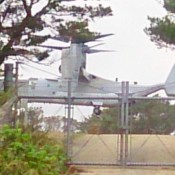
February 26, 2015 Ryukyu Shimpo
The U.S. military plans to build military helipads as a condition of the partial return of its Northern Training Area. At a newly built helipad in the N4 area on February 24, local citizens confirmed the U.S. military had carried out MV-22 Osprey aircraft training. The Japanese government provided the area to the U.S. military before returning another section of land occupied by the military to landowners on February 24. The military officially started using the helipad on February 24. This is the first time the Osprey training has been confirmed. The N4 area is the closest to Takae Village. An increase in Osprey and other aircraft flight training is expected to reduce the quality of life and safety of the village, due to noise pollution, safety risks, and negative impacts on wildlife.
According to residents who saw the Osprey flight training, the aircraft landed on N4-2 helipad once at 11:23 a.m., and flew over the sky in an area close to N4. At around 4:20 p.m., another aircraft flew to the area and then landed on N4-2 and N4-1 helipads. Upon landing, the aircraft blew dust and generated huge noise.
The military is scheduled to carry out Osprey flight training an estimated 2,520 times a year at newly built helipads in the Takae district of Higashi Village and the Aha district of Kunigami Village. The estimated number is double the number of flight training for the CH-46 Sea Knight helicopters at existing helipads. While the Okinawa Defense Bureau carried out an environmental assessment prior to building helipads, it did not factor in the impact of Osprey aircraft training because it did not know at the time the aircraft would be used. This has presented a problem.
The construction of two helipads in the N4 area was completed in July 2014. The Japanese government provided them to the U.S. military on February 17. However, the military used these helipads two times before they were officially handed over. On February 23, Higashi Village Assembly resolved to request the military not to use the N4 area for Osprey flight training.
The bureau contracted Nakahodo Construction to build the helipads in the G area in Aha for 190 million yen. The construction is scheduled for completion by March 31, 2016.
(English translation by T&CT)
Go to Japanese
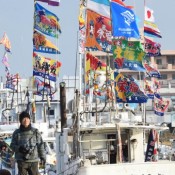
February 19, 2015 Ryukyu Shimpo
On February 19, which is the Lunar New Year, the fishing village of Itoman was surrounded by a vibrant scene. Many fishing ships hoisted colorful flags praying for good catch and safety. Worshippers, who have wooden boxes, containing food offerings to gods, visited Hakugindo shrine from early morning to pray for health and happiness for the New Year.
Fisherman Kaoru Kinjo, 54, said, “I hoisted flags to wish for a good catch this year. I hope 2015 will be a year of great progress.”
Masako Uehara, 73, visits Hakugin Shrine every Lunar New Year. She said, “I put my hands together and prayed for all my family’s health for this year. I feel good to visit the shrine at the beginning of the year. I think this year is going to be one of the best years.”
(English translation by T&CT, Hitomi Shinzato)
Go to Japanese
February 19, 2015 Ryukyu Shimpo
The number of foreign tourists visiting Okinawa rapidly increased during observation of the Lunar New Year which began on February 18. The shortage of hotel rooms in Okinawa has been due to overlapping events such as professional baseball spring training camps and school trips. Some of the hotels had almost full occupancy from the 19th to the 21st.
Usually, travel agencies keep a hold on rooms, but they cancel bookings for the week of Lunar New Year. However, due to the increasing number of foreign tourists taking advantage of low cost carriers and charter flights from overseas, those rooms have not been made available.
There has been an increase in reservations from individual customers anticipating the travel agencies’ Lunar New Year cancellations. To deal with the shortage of accommodation, some hotels have responded accordingly by recommending less occupied hotels to the customers.
According to the Okinawa Tourist Service (OTS), the hotels on the main island of Okinawa were almost fully occupied from the 19th to the 21st. A representative of OTS said, “While it is also because of the overlapping Lunar New Year and baseball camps, the rapid increase in inbound tourists is a major cause of the shortage of rooms.”
The Okinawa Prefectural Government as well as the Okinawa Convention & Visitors Bureau has started hearing investigation into twenty tourism agencies that provide service to foreign tourists, to respond to the scarcity of accommodation. A request to provide information on room availability has also been made to the Prefectural Hotel Association as well as the Prefectural Hotel and Inn Environmental Health Association.
According to the prefectural government, some tourists on group tours have been staying at different hotels as the high demand makes it very difficult for the tour members to all stay at the same hotel. However, there has been no report of overbooking or cases where tour groups are not able to stay at hotels.
(English translation by T&CT and Sayaka Sakuma)
Go to Japanese
February 23, 2015 Ryukyu Shimpo
Naha City Assembly unanimously adopted a resolution asking the Japanese government to stop the land reclamation work at Henoko to build a new U.S. air base and taking excessive actions against citizens protesting the work (33 votes in favor versus 4 against). They will send the resolution letters to Prime Minister Shinzo Abe, the Defense Ministers of Japan, and the head of the 11th Regional Coast Guard Headquarters.
Assembly members from the conservative Shimpu Kai, the Communist Party, Social Democratic Party, the Okinawa Social Mass Party, and the Independent Members Association jointly proposed the bill. The assembly members from the Komei Party, the Hiyamichika Naha Independent Members Association, and the Naha Democratic Party, favored it. Those from the Liberal Democratic Party (LDP) opposed the resolution. A representative of the LDP assembly members said, “The proposers of the bill did not demonstrate objective evidence of excessive actions against citizens.”
In the resolution, the assembly members pointed out the Japanese government has refused to meet the Okinawa Governor Takeshi Onaga, has ignored his request to stop the reclamation work and secure the safety of citizens, and is forcing through the landfill. They claimed that such acts are against democracy, and should never be tolerated.
(English translation by T&CT)
Go to Japanese
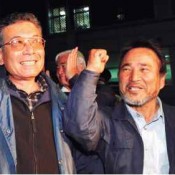
February 24, 2015 Ryukyu Shimpo
On the evening of February 23, the Naha District Public Prosecutor’s Office released Hiroji Yamashiro, 62, the director of the Okinawa Peace Movement Center, and Daigaku Tanimoto, 63, from Miyakojima City. The two men were arrested on suspicion of violating the Act on Special Measures Concerning Criminal Cases by the U.S. forces in front of Camp Schwab on February 22. They were subsequently handed over to Japanese investigating authorities. The public prosecutor’s office released them, because there is no risk of destruction of evidence or fleeing. They were detained for about 35 hours by the U.S. forces and the Japanese authorities.
When the activists came out the gate of the Nago Police Station, about 100 people welcomed them with applause. Yamashiro expressed his gratitude towards the people, saying, “I could hear your voices, and you sounded powerful.” “It is an almost groundless arrest. Maybe they feared the Okinawan people’s rally to be held later that day,” he added. “We need to take more care in the movement not to give them any opportunity to make such arrests. We would like to act legitimately and raise strong voices against the new U.S. base construction.”
The news that the two men were released reached the sit-in residents in front of Camp Schwab. Hiroshi Inaba, 64, from Shizuoka prefecture, said, “They should not have been arrested. But, we are happy. We will act all together to help anyone who will be apprehended. We have confidence to win victory in the struggle.”
At 7:00 a.m. on this day, in front of the gate, many people gathered. At 9:00 a.m., in front of the Nago Police Station, the protesters raised their voices: “Let’s release our brothers!” “Don’t allow a wrongful arrest!”
Protest actions continued successively until the evening.
(English translation by T&CT)
Go to Japanese
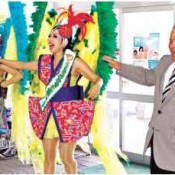
February 23, 2015 Ryukyu Shimpo
On February 16, the Samba duo Miyagi sisters became the first tourism ambassadors for Ogimi Village. Their parents were from the Nerome district of the village. The Miyagi sisters have been participating actively in Brazil where samba dance originated. A spokesperson for the village said, “We would like the Miyagi sisters to connect Ogimi to the world.” Receiving a certificate from the village mayor Norimitsu Miyagi, the Miyagi sisters said that they would like to promote Ogimi to the world.
The Miyagi sisters performed samba dance at the village office, and the village mayor Miyagi took part.
The Miyagi sisters, the eldest Kayoko and youngest Yayoi, took part in a samba carnival held in Brazil as “passista (solo)” dancers from the acclaimed samba group Aguia de Ouro in March 2014.
The village mayor Miyagi said, “We are probably relatives because we have the same last name.” He attached sashes to the sister’s sleeves and asked them to promote the charms of the village, including local farm product, Citrus depressa. The Miyagi sisters presented their newly released CD and posters to villagers.
The sisters’ uncle is a Citrus depressa farmer in the village. The Miyagi sisters come to help him in the picking season. Kayoko said, “I would like to promote the beauty of the people and sea of Ogimi to people around the world and make them want to visit the village.” Yayoi said, “I want to learn more about Ogimi and be vocal about promoting the village.”
(English translation by T&CT)
Go to Japanese
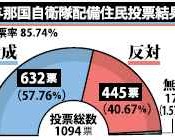
February 23, 2015 Ryukyu Shimpo
The Ministry of Defense plans to place a coastal monitoring unit for the Ground Self-Defense Force (JGSDF) on Yonaguni Island. A referendum asking residents if they accept the unit was held on February 22. The polls showed that a majority favored the JSDF deployment. The polls find 632 voters (57.76 percent) favor the unit deployment, 445 voters (40.67 percent) not in favor and 17 voters (1.57 percent) invalid. The total number of voters was 1,276 people and voter turnout was 85.74 percent.

Yonaguni Mayor Shukichi Hokama welcomes the result of the referendum on the JGSDF's unit deployment at the town office on the evening of February 22.
Mayor Shukichi Hokama stated he would speed up works, and bring in an act to abolish the public road running over the planned site for the unit. However, the act was rejected by the majority of opposition party voters of the town council last year. The opposition party is still the largest group on the town council. The residents opposing the JGSDF’s deployment plan to file a lawsuit to stop the construction, alleging that electro-magnetic waves produced from the radar will cause health problems .
The Ministry of Defense aims to complete the deployment of the unit by the end of March 2016. It plans to place about 150 personnel on the island in order to strengthen defense for the national boundary regions, and deter growing Chinese military power in the ocean. The government is carrying out the site preparation.
The town council adopted a resolution to host the JGSDF in 2008. Since then, the residents have been divided between those who want to host the JGSD’s unit deployment and those who reject the proposal. The group that support the unit deployment say that the popular will has been shown because Mayor Hokama who favors the unit deployment was elected twice. But, in the election of council members held in September 2014, the opposition party increased by one seat. The council consists of three members of the ruling party and three of the opposition party. As the chairperson was elected from among members of the ruling party, the opposition party has become the majority. It passed the referendum ordinance.
(English translation by T&CT)
Go to Japanese
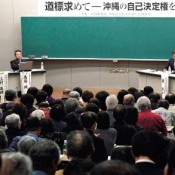
February 16, 2015 Ryukyu Shimpo
On February 15 at the Okinawa International University, Ryukyu Shimpo and the Okinawa International University Institute of General Industrial Research held a forum called “Seeking a course-discussions of Okinawa’s right to self-determination.”
Intellectual panelists talked about the vicious cycles of discriminatory and colonial situations following the annexation of the Ryukyu Kingdom, known as the Ryukyu disposal in 1879, and World War Two, in which Okinawa was sacrificed. They claimed that now is the time for Okinawa to claim the right to self-determination and peace. They added that Okinawa could be a hub of conversations and exchanges in Asia.
Kang Sang-jung, president of Seigakuin University, suggested Okinawa declare itself as a demilitarized autonomous zone in Asia. Other intellectuals suggested Okinawa should make use of business opportunities with Asia and develop a cosmopolitan hub of human resources for Okinawa’s economic self-sufficiency.
Kang delivered a keynote speech with the title of “Ryukyu and Asia-debates over sovereignty.” Kang explained that the role of the U.S. military in Okinawa will diminish if Okinawa can build a security framework among Asian countries and regions. He said, “In order to do so, we need to overcome the issue of the divided Korean peninsula which is a symbol of the disjuncture of Asia.” Kang continued, “We need to stop the Cold War in the Korean peninsula, and strengthen the ties of solidarity in Asia.”
The first session was a discussion on the theme of “Lessons from history, and looking to futures.” Professor Hideaki Uemura of Keisen University pointed out the annexation of the Ryukyu Kingdom is internationally illegal based on treaties such as the 1854 Ryukyu-U.S. Treaty of Amity.
Beijing Normal University Associate Professor Kyo Ko claimed, “If East Asia is not at peace, Okinawa is not peace. If Okinawa is not at peace, there will be no peace in East Asia.” He said he hoped to promote exchanges between Okinawa and China.
Referring to the issue of the relocation of Futenma Air Station to Henoko, Professor Tsuneo Namihira of the University of the Ryukyus stated, “Now is the time to claim our self-determination and peace.”
Professor Jun Shimabukuro of the University of the Ryukyus said, “First of all, it is crucial to create the Bill of Rights for Okinawa. For that, it is important for people in Okinawa to be aware that we are subjects who hold the rights to self-determination.”
In the second session “Rights to Self-determination and the Economy of Okinawa,” Professor Moritake Tomikawa of Okinawa International University (OIU) explained that business expansion in Asia has started. Professor Ken Nakachi of OIU suggested promoting medical tourism. Chokei Taira, Kariyushi Group CEO, said, “Okinawa needs to decide on its own tourism infrastructure development and acquire the right to control relaxation of regulations.” Ryo Okada of Naha Business Incubate Office stated, “Transferring the latest information technology to Okinawa is very important.”
About 600 people audited the panel discussions.
(English translation by T&CT and Megumi Chibana)
Go to Japanese








 Webcam(Kokusai Street)
Webcam(Kokusai Street)


